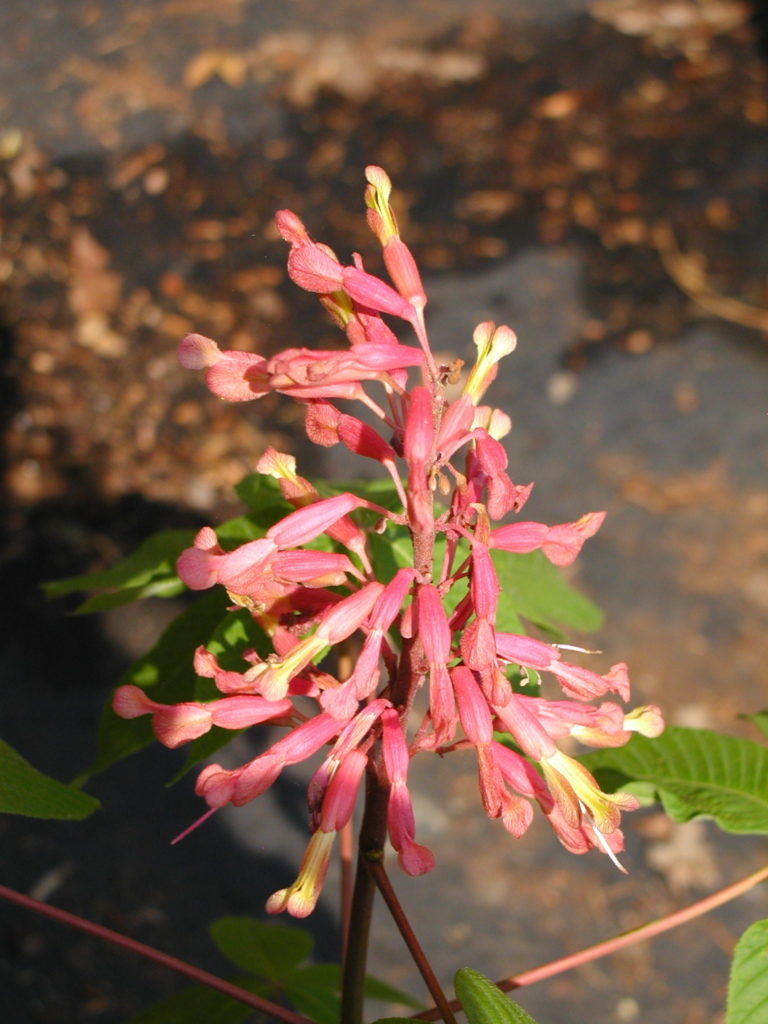Aesculus pavia or Red Buckeye is a deciduous, clump-forming shrub or small tree (ten to fifteen feet) native to the Southeast from Virginia over to Texas and Oklahoma. In NC it is found in central Piedmont and southern Coastal counties. This shrub has much to offer in the mesic garden: its beautiful, tender young leaves emerge very early in the season, before much else in the woods is budding out. These become 5- to 10-inch, glossy, dark green, palmately compound leaves. Soon, 4-10-inch long panicles of erect, red to orange-red, tubular flowers follow for bright splashes of color. Red Buckeye attracts hummingbirds, butterflies and many other pollinators into the garden. In late summer it produces pear-shaped capsules containing handsome, shiny, inedible Buckeye seeds. While Buckeyes are among the earliest to bud out in our creek bottoms, they are also early to senesce, the fruit ripening and leaves dropping as early as August. Importantly, Red Buckeye is one of the very few really deer-resistant, smallish trees native to our area.
NURSERY HOURS
Wednesday: 10-4 Thursday: 10-6 Friday-Saturday: 10-4 Sunday: 12-4
Aesculus pavia

Key Info
Scientific Name: Aesculus pavia L.
Common Names: Red Buckeye, Scarlet Buckeye, Firecracker Plant
Family Names: Sapindaceae (Soapberry Family)
Plant Type: Tree / Shrub
Leaf Retention: Deciduous
Flower Color: Red, orange-red
Special Characteristics: Showy fruit, Attracts bees, Attracts butterflies, Reported to be deer resistant., Attracts Hummingbirds, Shade tolerant
Additional Info
Habit: Usually single-stemmed, open small tree
Height: 10-20'
Spread: 12-15'
Soil Conditions: Average, slightly acid.
Leaves: Opposite, palmately compound w/ 5 leaflets fine-toothed, glossy dark green above and whitish beneath. 5-10"
Flowers (or reproductive structures: Erect, 4-10” long panicles of red to orange-red, narrow-tubular flowers
Fruit: light brown, thin-walled 1-3" dehiscent capsule w/ 1-3 shiny inedible nuts inside called buckeyes, maturing in late summer to early fall
Natural Distribution: Mesic woods and ravines from North Carolina south to Florida, west to central Texas, and as far north as Illinois
USDA Hardiness Zone: 4 to 8
USDA Wetland Indicator Status in NC: FAC (FACU on Coastal Plain)
Pollination: Ruby-throated hummingbirds, butterflies
Wildlife Connections: The flowers attract Ruby-Throated Hummingbirds which are present at the right time to pollinate them; they also attract butterflies.
Propagation: By seed, which will germinate as soon as ripe.
